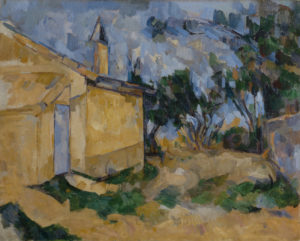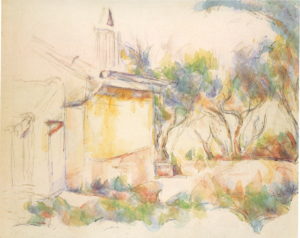R947 – Le Cabanon de Jourdan, 1906 (FWN380)
RW645 – Le Cabanon de Jourdan, 1906
Pavel Machotka
(Cliquer sur les images pour les agrandir)
Le Cabanon de Jourdan was almost certainly painted in the summer of 1906 and if, as is believed, it is Cézanne’s last landscape[1], then it suggests that his ultimate aim was not abstraction but an image in which the discrete patches of the surface became whole. When he spoke of his difficulty in joining his separate touches, he revealed that intention; we as viewers, however, tend to be particularly fascinated by the late landscape paintings which stop short of that goal. But Le Cabanon de Jourdan is fully finished, and it is remarkable in achieving an integration of two systems: that of patches and that of a powerful linear design.
The watercolor (RW645) was conceived, and finished, in discrete touches of color, very much like La Route tournante, RW629. In it, Cézanne elaborated the trees and bushes of the foreground, as if testing out the force of their rhythms (which he made very graceful). He left the sky untouched and barely indicated the color of the wall—flat expanses of color being unsuitable to the unity of the aquarelle, as we have seen in Maison près d’un tournant en haut du chemin des Lauves (RW629).
In both versions the composition — a single flat wall receding sharply into space — was rare in Cézanne’s practice. In the aquarelle, the recession is simply stopped by placing the end point of the wall in the center of the composition, at a point of equilibrium, and is then opposed by the counterthrusts of the curving branches. In the oil, with the wall painted in, the composition became heavy on the left side, so Cézanne took in a broader view of the scene and brought in the wall at the right edge; this redressed the balance (as it did in Ferme à Montgeroult, with two walls opposing each other). Now there was less onus on the curved lines of the trees; Cézanne chose to emphasize their mass and unite them with a massive sky, trees and sky curving in unison toward the top of the chimney.
The ground, now also done in geometric patches, became a series of diamond shapes that interconnected like the tiles or parqueting of a floor, and at the blue door the green diamonds were joined together in a curve to mirror the principal curving branch. As in the watercolor, the roof was left off—perhaps to keep the diagonal movement as simple as possible—but the sky filled the space the roof had vacated and even invaded part of the chimney. The chimney has taken on a sharp point here, as if it were meant to attract the eye—an exception to his rule—but this, too, has an incisive effect on the composition: it strengthens the dynamics of the receding walls. Le Cabanon de Jourdan is not a “last” landscape in any sense except that none have followed it; on the contrary, as if looking to the future, it takes risks, and is as clear in its purpose as the hand that painted it was firm.
Source: Machotka, Cézanne: The eye and the Mind.
[1] Rewald, PPC, vol. 1, p. 555.



